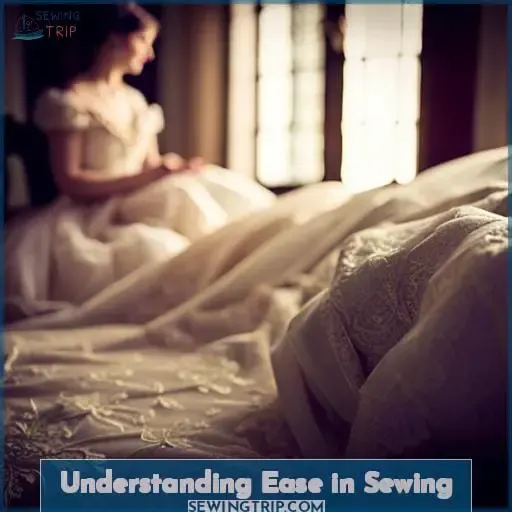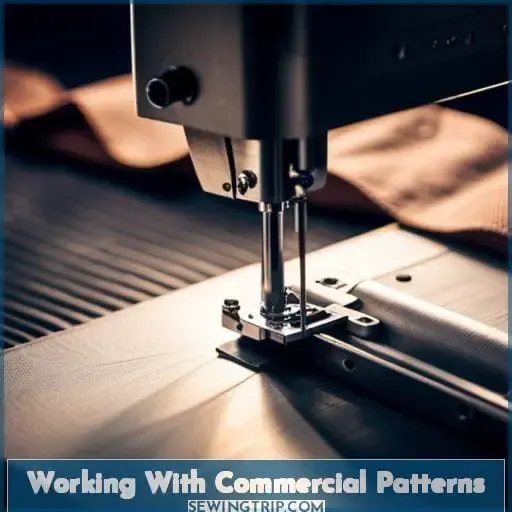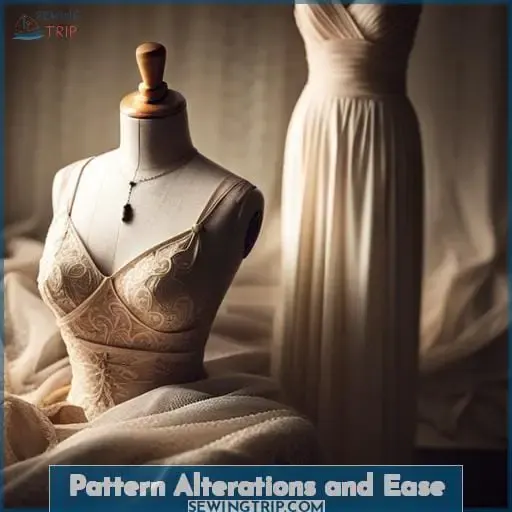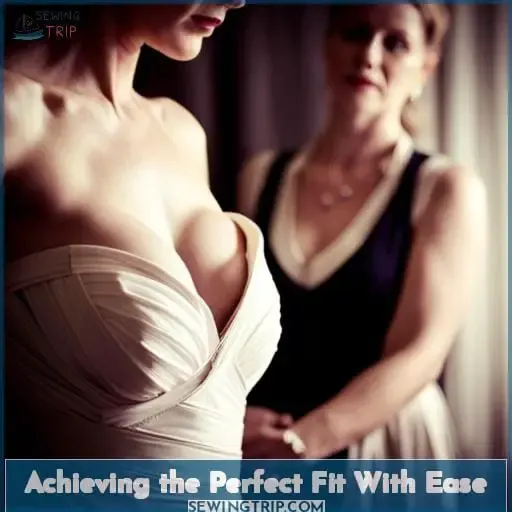This site is supported by our readers. We may earn a commission, at no cost to you, if you purchase through links.
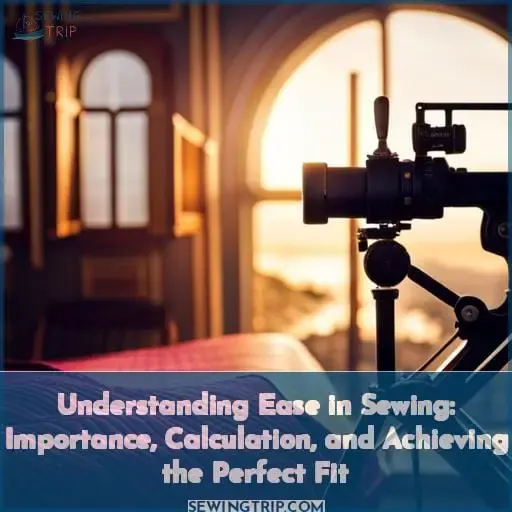 Imagine effortlessly creating garments that fit you perfectly, allowing you to move with ease and confidence. Understanding the concept of ease in sewing is key to achieving this level of mastery in your craft.
Imagine effortlessly creating garments that fit you perfectly, allowing you to move with ease and confidence. Understanding the concept of ease in sewing is key to achieving this level of mastery in your craft.
In this article, we will delve into:
- Why ease is important for movement and style
- How to calculate the right amount of ease for a perfect fit
- Tips on working with commercial patterns
Get ready to unlock the secrets behind achieving comfortable and flattering clothing that truly reflects your personal style.
Table Of Contents
- Key Takeaways
- Understanding Ease in Sewing
- Determining the Amount of Ease
- Working With Commercial Patterns
- Accessibility of Ease Charts From Major Pattern Companies Online
- Interpretation of Total Ease Indicated on Commercial Patterns
- Calculating Ease by Comparing Body and Finished Garment Measurements
- Adjustments and Alterations Based on Ease Calculations
- Sizing Up a Pattern to Accommodate Different Measurements
- Pattern Alterations and Ease
- Achieving the Perfect Fit With Ease
- Reader Interactions
- Frequently Asked Questions (FAQs)
- Conclusion
Key Takeaways
- Ease is crucial for movement and comfort.
- Different fabrics have varying stretch and drape, which affect ease requirements.
- Style choices and desired fit impact the amount of ease needed.
- When sewing, it is important to consider body measurements, fabric choice, and desired fit to achieve the perfect balance of ease.
Understanding Ease in Sewing
Let’s start by understanding what ease means in the context of sewing.
Ease refers to the additional space incorporated into a garment for movement, comfort, and breathability. It’s an essential element that distinguishes between wearing ease, which allows freedom of movement, and design ease, which contributes to the overall style and fit of a garment.
By grasping these concepts, you’ll be able to create garments that not only look good but also feel comfortable when worn.
Definition of Ease in Sewing
Ease in sewing is a fundamental concept that determines the space and comfortability of a garment, allowing you to move freely and breathe easily while wearing it.
- Importance: Ease ensures comfort and freedom of movement.
- Calculation: It involves considering body measurements, finished garment measurements, and desired fit.
- Definition: Ease is the difference between body measurement size and final garment size.
Distinction Between Wearing Ease and Design Ease
Now let’s delve deeper into the distinction between wearing ease and design ease in sewing.
Do you ever wonder how these two types of ease contribute to the overall fit and comfort of your garments?
Wearing ease refers to the additional space added to body measurements for comfortable movement, while design ease is a deliberate choice made by designers for styling purposes.
Understanding these types of ease allows you to find the perfect balance between garment fit, comfort, and personal preferences in style.
Importance of Ease for Movement and Style
One of the key aspects to consider when understanding ease in sewing is its importance for your movement and style.
Ease ensures that your garments allow you to:
- Move freely
- Sit comfortably
- Maintain a stylish silhouette
By calculating the right amount of ease based on your body measurements and design preferences, you can achieve a perfect fit that combines both comfort and fashion.
Whether it’s easing stitching or fitting sleeves, incorporating sewing ease is essential for creating well-fitting garments that enhance your mobility while looking fabulous.
Ease as a Necessary Component for Comfortable Clothing
To ensure comfortable clothing, it’s essential to understand that ease in sewing serves as a necessary component.
Here’s why ease is important for comfortable garments:
- Comfort Importance: Ease allows for freedom of movement and breathability.
- Fit Balance: It ensures the right balance between body measurements and garment fit.
- Movement Freedom: Ease provides flexibility and comfort during activities.
- Style Enhancement: Properly incorporated ease enhances the overall look of the garment.
Relationship Between Ease and Garment Fit
When it comes to achieving the perfect fit in sewing, understanding the relationship between ease and garment fit is essential.
Ease calculation plays a crucial role in determining how a garment will sit on your body, taking into account style preferences and allowing for necessary fit adjustments.
By mastering ease in sewing, you can overcome common sewing challenges and create garments that flatter your shape with confidence.
| Garment Fit | Ease Calculation | Style Preferences |
|---|---|---|
| Determines how well clothing fits your body’s shape | Ensures proper allowance for movement while maintaining comfort. | Influences design choices based on personal taste |
Determining the Amount of Ease
Now that you understand the importance of ease in sewing, let’s discuss how to determine the amount of ease needed for your garment.
Several factors come into play when calculating wearing ease, such as body measurements and fabric choice. Guidelines can be followed to add appropriate amounts of wearing ease to ensure a comfortable fit.
Additionally, personal preferences and desired garment style also contribute to determining design ease. By considering these factors, you can achieve the perfect balance between comfort and style in your finished piece.
Factors Influencing the Amount of Wearing Ease Needed
To determine the amount of wearing ease needed in your garment, consider various factors that influence this measurement:
- Easing Techniques: Understanding different methods for easing fabric can impact the amount of ease required.
- Fabric Preparation: The type and stretchiness of the fabric will affect how much ease is necessary.
- Sewing Sleeve Caps: Properly sewing sleeve caps requires careful consideration of ease to ensure a comfortable fit.
- Cheater Method Caution: Although it may be tempting, caution should be exercised when using shortcuts like the cheater method for easing fabric.
- Additional Sewing Resources: Explore additional resources to learn more about calculating and achieving proper wearing ease.
Guidelines for Adding Wearing Ease to Body Measurements
When determining the amount of ease to add to body measurements, use these guidelines for adding wearing ease:
- Consider fit preferences and comfort balance when calculating ease.
- Take into account the fabric’s impact on drape and stretchability.
- Style choices also influence the desired amount of ease in a garment.
Whether it’s a pattern mashup or working with knit fabrics, understanding how to add appropriate wearing ease is key in achieving the perfect fit for your sewing projects.
Adding wearing ease is an essential step in creating garments that not only fit well but also feel comfortable to wear. It involves considering various factors such as personal preferences, fabric properties, and style choices.
To calculate the right amount of wearing ease for your project, start by taking accurate body measurements using a flexible tape measure while keeping posture natural (not too relaxed or tense). Next, determine your desired level of comfort balance based on whether you prefer close-fitting or loose-fitting garments.
The type of fabric you choose will greatly affect how much additional room you need for movement and breathability.
- Knit fabrics have inherent stretchiness that allows them to conform closely without excessive added width like woven fabrics.
- If working with non-stretchy materials like woven cottons or linens, consider adding more moderate levels of wearing Ease because they don’t naturally provide give.
Style choices are another factor influencing easing calculations; fitted styles may require less extra space than loose silhouettes where increased freedom is desired.
By following these guidelines when determining fitting adjustments involving easement addition during garment construction , sewists can achieve comfortable clothing pieces which allow unrestricted movement while still looking stylish.
Impact of Fabric Choice on Ease Requirements
When choosing fabric for your sewing project, it’s important to consider the impact of fabric choice on ease requirements in order to determine the amount of ease needed for a perfect fit.
Different fabrics have different levels of stretch and drape, which can affect how much ease is necessary.
The material choice also plays a role in achieving the desired style and comfort balance.
By carefully considering fabric selection, you can ensure that your garment has the right amount of ease for optimal fit and functionality.
Determining Design Ease Based on the Desired Garment Style
Now let’s determine the amount of ease needed for your desired garment style.
When considering design ease, it’s important to take into account various factors such as the silhouette, fabric choice, and personal preferences.
Garment styles can range from close fitting to very loose fitting, each requiring different amounts of ease.
Design considerations play a crucial role in achieving the desired look and comfort level of your finished garment.
Explore different pattern variations and easing techniques to create garments that fit perfectly with style and grace.
Personal Preference as a Variable in Ease Calculations
To determine the amount of ease needed in a garment, take into account your personal preferences as they play a significant role in calculating the perfect fit.
- Consider how you like your clothing to feel on your body – snug and fitted or loose and relaxed?
- Think about the style you want to achieve – do you prefer a more tailored look or something with more volume?
- Take note of any specific comfort requirements you have, such as needing extra room for movement in certain areas.
- Remember that customization is key when it comes to achieving a garment that meets both your style preferences and overall comfort.
Working With Commercial Patterns
When working with commercial patterns, it’s important to have access to ease charts provided by major pattern companies online.
These charts can help you interpret the total ease indicated on the pattern and calculate the necessary adjustments and alterations based on your specific measurements.
By comparing your body measurements to the finished garment measurements, you can determine if any additional sizing up or down is needed to accommodate different areas of ease.
With these tools at hand, you’ll be able to confidently work with commercial patterns and achieve a perfect fit for your sewing projects.
Accessibility of Ease Charts From Major Pattern Companies Online
If you’re working with commercial patterns, it’s convenient to have accessibility to ease charts from major pattern companies online.
These online resources provide valuable information on how much ease is included in their patterns, helping you achieve the perfect fit for your garments.
By referring to these charts, you can ensure that the garment will have the desired amount of ease and create a comfortable and flattering fit.
Make use of these helpful tools alongside sewing tutorials for optimal results in achieving your garment fit goals.
Interpretation of Total Ease Indicated on Commercial Patterns
When working with commercial patterns, accurately interpreting the total ease indicated is crucial for achieving a proper fit in your garment.
Understanding how to interpret these patterns will allow you to make necessary fit adjustments and calculations.
By comparing body measurements with finished garment measurements, you can determine the amount of ease needed and make any necessary alterations.
These sewing tips will help ensure that your final product fits perfectly and allows for freedom of movement.
Calculating Ease by Comparing Body and Finished Garment Measurements
How can you calculate ease by comparing your body measurements to the finished garment measurements when working with commercial patterns?
- Measure your body accurately using a tape measure.
- Compare those measurements to the finished garment measurement provided on the pattern envelope or instructions.
- Evaluate how much ease is included in the pattern based on this comparison.
Adjustments and Alterations Based on Ease Calculations
When working with commercial patterns, it’s important to make adjustments and alterations based on the ease calculations you have determined.
Sleeve easing requires careful fabric preparation and precise easing stitching at the top of the sleeve cap. Remember to be patient when redistributing fabric through easing stitching, ensuring a taut yet flat result.
While a cheater method exists for heavy fabrics, use it sparingly as it can cause bunching and multiple tucks.
Achieving fit perfection takes attention to detail in these adjustments.
Sizing Up a Pattern to Accommodate Different Measurements
To accommodate different measurements, you can size up a commercial pattern.
Start by measuring your body and comparing it to the pattern’s measurements.
Consider factors like grainline and ease allowance when making adjustments for a better fit.
For garments with princess seams or negative ease in knit fabrics, understanding fabric choice is crucial for achieving the desired fit.
Sizing up patterns allows you to create clothing that fits your unique measurements while maintaining comfort and style.
Pattern Alterations and Ease
When it comes to pattern alterations and achieving the perfect fit, factoring ease into your adjustments is crucial.
Whether you’re sizing up a pattern to accommodate a different size or making other alterations, calculating the added ease needed is essential for maintaining balanced proportions in your garment.
Ensuring that ease remains consistent throughout the adjustment process will help you achieve a well-fitted and comfortable final product.
Factoring Ease Into Pattern Size Adjustments
When making pattern size adjustments, it’s important to factor ease into the equation.
- Calculating ease based on body measurements
- Making necessary pattern adjustments for size modifications
- Understanding how ease affects overall garment fit
- Ensuring consistent ease calculations throughout the alteration process.
By taking these steps, you can create a well-fitting garment that provides both comfort and style.
Example of Sizing Up a Pattern to Accommodate a Different Size
To accommodate a different size, you can easily size up a pattern by making alterations and considering ease in sewing.
Start by measuring your body and comparing it to the pattern measurements. Identify areas that need adjustment, such as bust, waist, or hips.
Use techniques like slashing and spreading or adding extra seam allowances to expand the pattern’s size.
Make fit modifications accordingly for a perfectly fitting garment that flatters your figure.
Calculating the Added Ease Needed When Altering Patterns
When altering patterns to accommodate a different size, it’s important to calculate the added ease needed for a well-fitting garment.
To ensure a successful fit adjustment, consider the following factors in your ease calculation:
- Measure and compare body measurements with pattern measurements.
- Determine the desired amount of wearing ease based on personal preference and garment style.
- Make necessary pattern modifications to add or remove ease as needed.
Calculating proper sizing ease is crucial for achieving a comfortable and flattering fit when altering patterns.
Ensuring Ease Remains Consistent When Adjusting Patterns
To ensure that ease remains consistent when adjusting patterns, maintain a balanced fit throughout the alteration process.
Consistent adjustments are crucial for achieving the perfect fit. By utilizing alteration techniques and pattern modifications, you can tailor the garment to your specific measurements and tailoring preferences.
Pay attention to maintaining fit balance between different areas of the garment to avoid any distortions or inconsistencies in ease distribution.
The Importance of Maintaining a Balanced Fit During Pattern Alterations
Maintaining a balanced fit during pattern alterations is crucial to ensure that the final garment hangs properly on your body.
Fit adjustments and tailoring techniques are essential for creating garments that flatter your figure. By mastering these skills, you can achieve sewing precision and create garments that fit like they were made just for you.
Garment alterations require attention to detail and careful execution to maintain the desired balance throughout the process.
Achieving the Perfect Fit With Ease
Now that you understand the importance of ease in achieving the perfect fit, it’s time to tailor that ease to your individual preferences for comfort and style.
By considering how much wearing and design ease is needed for each garment, you can ensure that it enhances the overall look without sacrificing comfort.
Balancing these two types of ease is crucial for optimal results, so take some time to carefully calculate and adjust as necessary.
Keep in mind that achieving a well-fitted and flattering finished product relies on understanding and utilizing the role of ease in sewing projects.
Tailoring Ease to Individual Preferences for Comfort and Style
To achieve the perfect fit with ease, you can tailor the amount of ease in your sewing projects to suit your individual preferences for both comfort and style.
Personalize your garments by finding a balance between wearing ease and design ease that aligns with your unique taste.
Consider comfort choices when deciding on the amount of ease to incorporate into each garment.
By customizing the fit according to your personal preferences, you’ll achieve sewing satisfaction like never before!
Ensuring Ease Enhances the Overall Look of the Garment
Ensure that ease enhances the overall look of your garment by achieving the perfect fit.
To achieve this, consider these factors:
- Enhancing appearance through well-fitted garments
- Maintaining garment balance for a flattering silhouette
- Understanding the style impact of ease on design aesthetics
- Creating harmony between fit and overall design
By carefully considering these elements, you can ensure that ease not only provides comfort but also enhances the visual appeal of your finished garment.
Balancing Wearing Ease and Design Ease for Optimal Results
Balancing wearing ease and design ease is crucial for achieving the perfect fit in your garments. It’s important to consider both comfort and style when determining the amount of ease in your projects.
Design preferences, fabric choices, and personal comfort all play a role in finding the right balance. By carefully calculating ease measurements, you can create garments that not only fit well but also make you feel confident and stylish.
Balancing Fit
| Design Preferences |
|---|
| Choose desired style |
| Determine design ease |
Comfort & Style
| Ease Calculations |
|---|
| Choose fabrics with stretch |
| Calculate total garment measurement by adding body + wearing + design |
| Ensure enough room for range |
| Use guidelines provided by pattern companies as reference points |
Final Considerations for Achieving the Desired Fit With Ease
To achieve the perfect fit with ease in your sewing projects, consider these final considerations:
- Pay attention to easing techniques when sewing sleeves or other areas that require a smooth and comfortable fit.
- Make necessary fit adjustments based on body measurements and personal preferences.
- Choose suitable fabric that will drape well and complement the desired garment styling.
- Select patterns that provide adequate wearing ease for optimal comfort and movement while maintaining an appealing silhouette.
The Role of Ease in Creating Well-fitting and Flattering Clothing
Ease plays a pivotal role in creating well-fitting and flattering clothing by ensuring that the garment conforms to your body’s unique shape and proportions.
When designing garments, consider your personal preferences and make design choices that enhance your desired silhouette. Styling tips can also help accentuate certain features or create balance in areas where more or less ease is needed.
Reader Interactions
Let’s talk about the different aspects of ease in sewing and how they contribute to achieving the perfect fit.
Wearing ease refers to the space added for comfortable movement, while design ease allows for personal style preferences.
Negative ease is essential when working with knit fabrics for a snug fit.
Understanding your body’s specific requirements will help you create garments that are both flattering and comfortable.
Don’t forget to save this article for future reference and check out our easy-to-sew patterns!
Wearing Ease
For an optimal fit, it’s important to consider the amount of ease that you personally prefer and find comfortable in your garments.
- Ease Calculation: Take into account your body measurements and how much extra room you want in your clothing.
- Fit Adjustment: Consider any specific areas where you may need more or less ease for a better fit.
- Comfort Balance: Find the sweet spot between enough room for movement and a flattering silhouette.
Design Ease
When it comes to achieving the perfect fit, it’s important for you to understand your personal preferences and comfort level with design ease.
Design ease refers to the additional space added in a garment beyond wearing ease for style choices and aesthetic purposes. It allows for movement and creates different silhouettes based on individual design preferences.
By considering your desired design ease, you can ensure that your garments not only fit well but also reflect your unique sense of style.
| Design Preferences | Ease Calculation | Garment Fitting |
|---|---|---|
| Close fitting | Body measurements | Snug |
| Fitted | Wearing Ease | Tailored |
| Semi-fitted | Design Preference | / |
Negative Ease
Did you know how negative ease can affect the fit of your knit fabric garments?
Negative ease is a technique used in sewing with stretch fabrics, particularly in creating fitted styles like body-hugging dresses or tops. By intentionally making the final garment measurements smaller than the body measurements, negative ease allows for a snug and form-fitting look.
It’s important to consider the stretch percentage of both the fabric and pattern when achieving this desired fit.
Understanding Your Body’s Personal Ease Requirements
Now let’s explore how to understand your own body’s personal ease requirements.
When it comes to garment comfort and achieving a tailored fit, considering your personal preferences is key. Ease adjustments play a crucial role in ensuring that the garments you sew align with your desired level of comfort and style.
By understanding the nuances of ease and its impact on fit, you can overcome sewing challenges and create clothing that truly reflects your individuality while providing freedom of movement.
Save This Article to Your Sewing Pinterest Board
To save this article to your sewing Pinterest board, simply click the Save button and choose the appropriate board.
Pinning techniques are valuable for organizing your favorite sewing resources and inspiration.
Remember to consider fabric choices when selecting projects that require ease in fitting.
Easing tips can help you overcome sleeve challenges and achieve a professional finish.
Embrace interactive sewing by engaging with fellow sewists on Pinterest, sharing ideas, and discovering new techniques together.
Shop Easy to Sew Patterns Here
Check out our selection of easy-to-sew patterns for a hassle-free sewing experience. Whether you’re a beginner or an experienced sewist, these patterns are designed to help you achieve the perfect fit with ease.
From tops and dresses to pants and skirts, we’ve a variety of styles available that will suit your personal preferences and body measurements.
Don’t let complicated patterns hold you back – shop now and unleash your creativity!
Frequently Asked Questions (FAQs)
What are the different types of ease in sewing patterns?
Choose from body measurements, wearing ease, and design ease.
Body measurements ensure a good fit while wearing ease allows movement.
Design ease is about style preference – close fitting to very loose fitting.
How can I determine the amount of ease needed for a specific garment?
To determine the perfect amount of ease for your garment, take into account factors like fabric choice and desired style.
Experiment with different measurements to achieve a fit that liberates and empowers you.
Are there any standard guidelines for adding wearing ease to body measurements?
To add wearing ease to body measurements, follow general guidelines:
- Around the bust, approximately 5cm;
- Waist, 5cm;
- Hips, 8cm.
However, personal preference and garment style play a role in determining the final amount of ease needed for optimal comfort and fit.
How do I calculate the added ease needed when altering patterns?
To calculate the added ease needed when altering patterns, measure the difference between your body measurements and the pattern’s finished garment measurements.
What are some common problems that can occur when sewing sleeves and how can I avoid them?
When sewing sleeves, common problems include tucks and gathers.
Avoid these by:
- Smoothing fabric as you sew
- Removing ease stitching after sewing
- Inspecting for any necessary fixes
Achieve sleeve-sewing mastery!
Conclusion
In the world of sewing, ease is the magical ingredient that transforms garments into perfect fits.
By understanding the concept of ease, you can create clothing that allows for effortless movement and reflects your personal style.
Whether you’re a sewing enthusiast, pattern designer, or fashion/costume designer, ease is the key to unlocking comfort and confidence in your creations.
So, embrace the importance of ease, calculate the right amount for a perfect fit, and watch as your sewing projects come to life in a way that truly reflects your individuality.

